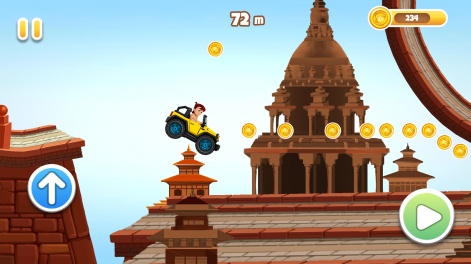From Star Wars: Galaxy of Heroes to Marvel: Contest of Champions, the role of existing IP in successful mobile games is no new phenomenon.
But in India, this seems even more pronounced. Of the handful of Indian-developed games that have topped the country's Google Play charts, the vast majority have relied on existing brands.
Mumbai-based publisher Nazara Games has led the way on this, working with popular Indian animation Chhota Bheem to release a number of successful tie-in mobile games.
More recently, the firm has partnered with Indian cricket team Royal Challengers Bangalore to launch RCB Cricket.
So just how important is this high-profile IP when it comes to building a successful mobile game in India? We asked our Indian Mavens:
- With the biggest mobile games in India relying on existing IP such as Chhota Bheem, are such deals now a prerequisite for success?
- What can Indian developers do to gain traction with their own IP?
This is a very interesting question at a very interesting time.
While it seems that it’s been established that a big-name existing IP such as Chhota Bheem or a blockbuster Bollywood movie is required for a guaranteed hit, I’m not entirely convinced that this is the only way to do this.
It is possible for games without licensed IPs to still hit the market and become successful.Hrishi Oberoi
While getting the license to an existing IP always increases the chances of visibility, user acquisition, as well as the possibility of featuring (considering that even the App Store curators recognise the IPs), all this is doing is taking the responsibility - or burden - of creating original quality content away from developers.
If we take a look at the parallels in the international markets, even there there are a few mobile hits which are dependent on existing IPs, but the majority of mobile hits are mostly original properties.
So it is possible for games without licensed IPs to still hit the market and become successful.
As an example closer to home, at Indiagames we created our first cricket game without the license of IPL or ICC and, surprisingly, that game is still in the top 100 today, nearly six years and 15 million downloads after its launch.
But that game, being based on an existing, recognisable format (i.e. cricket as a sport), is probably not the best example.
So the question would be how would an Indian team create their own IP which can gain traction? Well, creating true original content which can be considered an IP in itself is very, very hard, especially in India.
Having said that however, here are a few points that are pertinent in doing so:
- Know Your Audience
The first thing developers need to do is to understand their audience absolutely to the core. Their likes, dislikes, fears, habits, spending power, motivations, wants, beliefs… everything!
It’s important for teams to understand the similarities of the audience to themselves so that they can relate to them, but more importantly, it’s crucial for developers to understand the differences of the audience to themselves so that they can create a plan on how they would go about plugging the gaps in the cultural disconnect.
- Cultural Content
For a country like India, the majority of people can relate to some sort of Indian cultural content.

This is even more apparent if we take a look at the parallels in other media formats in India (i.e. films, TV, music and even comics and internet videos) where Indian content always trumps international content as far as pure reach and revenues are concerned.
- Dogged Perseverance
For building new IPs, success is only possible with consistency and dogged perseverance.
Even when Chhota Bheem first came onto TV, the animation industry was very happy consuming syndicated shows from the West and loads of dubbed Tom & Jerry episodes.
But the Green Gold team persevered, put their money where their mouth is and paid for all the production of the episodes themselves and therefore got to keep their IP themselves.
Even that didn’t get them success right off the bat, they had to wait for quite a few episodes to air before it really caught viewers' attention.
- Quality Core Game
Since we are talking about original IPs for games here, it goes without saying that the quality of the game itself needs to be extraordinary and it should be able to compete with the international games that are vying for the number one position in the charts.
Unless a company can create their own original IP, a long-term successful business cannot be established.Hrishi Oberoi
Even if there is thematic resonance and cultural fit, if the quality of the core game cannot compete with Subway Surfers in polish and quality (which seems to hold a permanent spot in the top three), it’s very unlikely the game would be successful.
In conclusion, I can say for a fact after working with a plethora of licensed IPs over the years at Indiagames as well as original IPs created at Disney, that in terms of pure business sense, licensed IPs are great for short-term and medium-term success.
But unless a company can create their own original IP, especially one which can stand the test of time, a long-term successful business cannot be established.
At Photon Tadpole, we firmly believe that this is the only path to lasting success and hopefully, very soon we will be able to share with you what we are doing to back our beliefs.

Shailesh Prabhu is an Indie Game Designer from India who has been designing games for over ten years. Seven years ago he founded Yellow Monkey Studios and is the recipient of numerous game design and entrepreneurship awards around the world. Socioball, HUEBRIX, It’s Just a Thought are some of his recent games. Shailesh is also an excellent cook, loves playing tennis, gardening and DIY projects apart from sporting facial hair.
I would like to point everyone's attention to this, from Fortune: 'Netflix says Geography, Age and Gender are “Garbage” for Predicting Taste'.
I would tend to agree with Netflix rather than unproven theories. Geography, age and Gender are indeed “Garbage” for predicting taste.
As far as success of things like Chhota Bheem go, it's more to do with exposure than anything else. And cultural content may not be a guaranteed success either.
Let’s take a closer look at what IP (in the context that we are talking here) means.
It means an entity that has a sizable fanbase or userbase that is associated with it. The number one need for any type of game is to have a ready community, and this issue is solved by associating your game with some IP.
I would not say that having an IP has always resulted in success for game devs. Not a lot of movie games or Indian comic-based games have been all that successful.
Hence generalising it just with one or two success stories will be misleading.
The best way to gain traction with your own IP is to create a fine game, which gives you as a creative person and the gamer inside you satisfaction.
Start building the community around your game while you work on it, as well as post-launch. Once you have sizeable userbase and you are able to keep them engaged for sizeable duration, you have a brand or IP.
So in my opinion, IP = engaged community. Bigger the community, better the IP.
To get traction on your game IP, just make good game and attract as many eyeballs as you can and your game will do the rest of the magic.
To attract eyeballs, you can make use of current trends / interests / existing userbase / advanced technology or even an outrageous marketing budget.
In the Indian market, to make the audience download the game we need to rely on existing IP and names.
But eventually things will change over the course of time. There are many indie games which have appeared in the top spots on Google Play and the App Store.
Games developed by small indie developers have got attention over the past few months.
To gain traction, one must concentrate more on the gameplay and fun elements in the game rather than concentrating on the IP values.

My name is Rituraj Behera and I am Co-founder of Cympl, an Indie game studio started back in November 2012.
I had begun my career as an application developer but I always loved playing games which attracted me to the fast growing mobile games industry.
I had started the organization with a vision to create high quality mobile games and an attitude to learn & improve everyday.
If the definition of success is millions of downloads then yes, relying on existing popular IPs is a pre-requisite for success.
But success means different things to different people. We need to be clear what our goals and our plans are and need to align to that accordingly.
Established IP must surely be taking a huge chunk of the revenues, which puts more pressure on performance.Rituraj Behera
For us at Cympl Studio, getting millions of downloads would be wonderful but is only an ingredient in the success story.
After getting enough relevant users, the game needs to be good enough to engage, retain and monetise users by constantly improving the game and adding more content, which eventually converts to revenues for the business.
Established IP must surely be taking a huge chunk of the revenues if we end up partnering with them, which puts even more pressure on game performance.
As for your own IP, focus on quality! When I say quality, I mean on every aspect of the game experience - including having a clear differentiator compared to other games in the market.
Once you have built a big enough community that loves to engage with your game, IP should be a natural effect.




















